 |
Canku Ota
|
 |
|
(Many Paths)
|
||
|
An Online Newsletter
Celebrating Native America
|
||
|
October 2014 - Volume
12 Number 10
|
||
|
|
||
|
Wake Up to a Total
Lunar Eclipse on October 8, 2014
|
||
|
by The Editors of Sky
Telescope
|
||
|
Start your day with an eclipse of the full Moon! On the morning of October 8, 2014, a total lunar eclipse will be visible across most of North America.
The one before dawn on Wednesday, October 8th, will be visible from nearly all of the Americas. Moreover, the Moon, two days after perigee, will be 5% larger in diameter than it was during the first eclipse of the tetrad on April 14-15 earlier this year. The map, diagram, and timetable below will tell what to expect at your location and when. If you’re in the central or western parts of the U.S. and Canada, you’ll see the total eclipse high in a dark sky well before sunrise. Easterners will find dawn brightening and the Moon sinking low in the west while the eclipse is in progress — offering particularly interesting photo opportunities. Viewers in Australia and eastern Asia get to view this event on the evening of October 8th.
How to Watch the Lunar Eclipse
The first penumbral stage begins when the Moon’s leading edge enters the pale outer fringe of Earth’s shadow, the penumbra. But the shading is so weak that you won’t notice anything until the Moon has intruded about halfway into the penumbra. Watch for a slight darkening to become apparent on the Moon’s celestial eastern side. The penumbral shading becomes stronger as the minutes tick off and the Moon moves deeper in. The second stage is partial eclipse. This begins much more dramatically when the Moon’s leading (eastern) edge enters the umbra, Earth’s central shadow, where no direct sunlight reaches. With a telescope, you can watch the edge of the umbra slowly engulfing one lunar feature after another, as the entire sky grows darker and darker. An hour or so into partial eclipse, only a final bright sliver of Moon remains outside the umbra. And the rest is already showing an eerie reddish glow. The third stage is the total eclipse itself, or totality, beginning when the last rim of Moon slips into the umbra. Although the Sun here is completely hidden, the Moon is sure to glow some shade of orange or red. This red light on the Moon is sunlight skimming and bending through Earth’s atmosphere: it’s the light of all the sunrises and sunsets that ring our world at any given moment. An astronaut standing on the Moon would see the Sun hidden and the dark Earth ringed with sunset- and sunrise-colored brilliance. On rare occasions the eclipsed Moon does go almost black. Other times it appears as bright as a fresh penny. Sometimes it turns brown like milk chocolate. Two factors affect an eclipse’s color and brightness. The first is simply how deeply the Moon goes into the umbra; the umbra’s center is much darker than its edges. The other factor is the state of Earth’s atmosphere along the sunrise-sunset line. If the air is very clear, the eclipse is bright. But if a major volcanic eruption has recently polluted the stratosphere with thin global haze, the eclipse will be dark red, ashen gray, or almost black. In addition, blue light refracted by Earth’s clear, ozone-rich upper atmosphere can also add to the scene, especially near the umbra’s edge, creating a subtle mix of changing colors. Time-lapse videos might show large “flying shadows” in the umbra, caused by changing cloud-shadowing effects around the sunrise-sunset line as Earth turns. Totality on October 14th lasts 59 minutes. And then, as the Moon continues eastward along its orbit, events replay in reverse order. The Moon’s leading edge reemerges into sunlight, ending totality and beginning stage four: partial eclipse again. When the entire Moon escapes the umbra, only the last penumbral shading remains for stage five. This final duskiness slowly fades away, leaving the full Moon as bright as ever.
How To Photograph the Lunar Eclipse With the prospect of the Moon changing from bright to dull red-orange and back again, don't overlook the possibility of recording this dramatic celestial event with your still or video camera! Photographing a total lunar eclipse isn't difficult — but it does take a little preparation.
Because the coloration and brightness of eclipsed Moon is different every time it plunges through the umbra — and even during totality itself — the best advice for photographing a lunar eclipse is to take lots of pictures at many different exposures. Count on using times of ½ second or longer during totality, so make sure your camera is able to make exposures that long, preferably in "manual" mode. Use a remote control (or the self-timer function) to minimize vibration during the exposures. S&T's imaging experts offer more great tips on how to photograph a lunar eclipse elsewhere on this web site. Uranus Too!
The actual position of the eclipsed Moon against the starry background in Pisces will depend slightly on where you are and the stage of the eclipse. The Moon on the chart is positioned for the middle of North America at the start of totality, but elsewhere the difference won't be more than a couple of Moon diameters at most. You should have no trouble finding the 4½-magnitude stars Epsilon (e) and Delta (d) Piscium north of the Moon. Identify Uranus by the shape of the triangle it makes with those two stars. Can you see anything of Uranus's aquamarine blue-green tint? Color contrast with the vivid orange-red Moon might make this more apparent. In a telescope, Uranus is a tiny disk 3.7 arcseconds wide. It's 2.6 light-hours from Earth, compared to the Moon's distance of 1.2 light-seconds. |
||||||||||||||||||||||||||||||||||||||||
|
|
||
|
|
||
| Canku Ota is a free Newsletter celebrating Native America, its traditions and accomplishments . We do not provide subscriber or visitor names to anyone. Some articles presented in Canku Ota may contain copyright material. We have received appropriate permissions for republishing any articles. Material appearing here is distributed without profit or monetary gain to those who have expressed an interest. This is in accordance with Title 17 U.S.C. Section 107. | ||
|
Canku Ota is a copyright ©
2000 - 2014 of Vicki Williams Barry and Paul Barry.
|
||
 |
 |
|
|
The "Canku
Ota - A Newsletter Celebrating Native America" web site and
its design is the
|
||
|
Copyright ©
1999 - 2014 of Paul C. Barry.
|
||
|
All Rights Reserved.
|
||
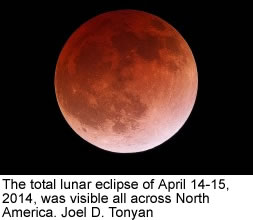 We’re
approaching the second of four total lunar eclipses that come at
half-year intervals in 2014 and 2015: a lunar-eclipse tetrad. All
four can be seen from at least parts of North America.
We’re
approaching the second of four total lunar eclipses that come at
half-year intervals in 2014 and 2015: a lunar-eclipse tetrad. All
four can be seen from at least parts of North America.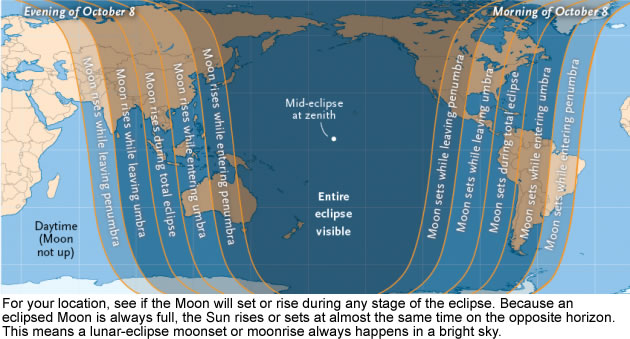
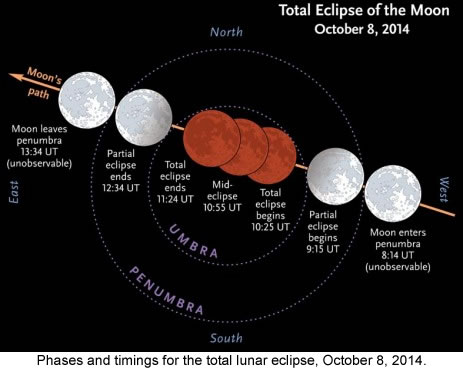 A
total lunar eclipse has five stages, with different things to watch
during each interval over a roughly 3-hour period.
A
total lunar eclipse has five stages, with different things to watch
during each interval over a roughly 3-hour period.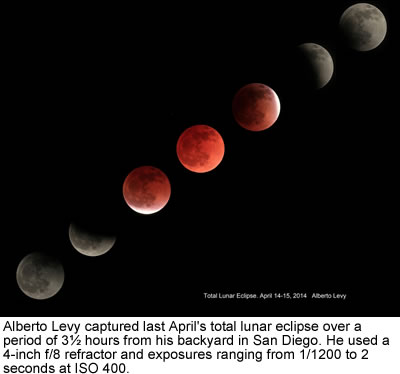 Most
importantly, you'll need a telescope or telephoto lens that enlarges
the Moon to a good size. The minimum focal length for getting a
good-looking Moon is about 300 mm. You'll also need a tripod to
keep your camera rock-steady, or you can piggyback your camera on
a tracking telescope mount.
Most
importantly, you'll need a telescope or telephoto lens that enlarges
the Moon to a good size. The minimum focal length for getting a
good-looking Moon is about 300 mm. You'll also need a tripod to
keep your camera rock-steady, or you can piggyback your camera on
a tracking telescope mount.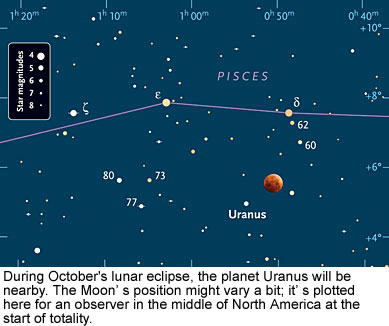 By
quite a coincidence the planet Uranus, just one day past opposition
and thus shining its brightest at magnitude 5.7, will appear only
about 1° from the Moon during totality. Spot it in binoculars
using the finder chart at right.
By
quite a coincidence the planet Uranus, just one day past opposition
and thus shining its brightest at magnitude 5.7, will appear only
about 1° from the Moon during totality. Spot it in binoculars
using the finder chart at right.